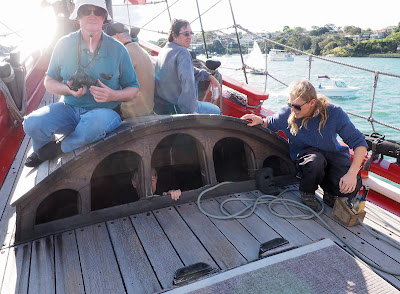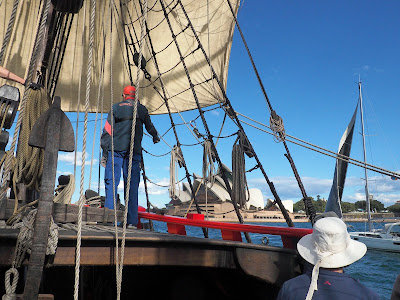Yesterday Catherine and I travelled up to Sydney to do a harbour cruise on the Duyfken - a replica of a 16th century Dutch merchant-ship.
The original ship was built in the Netherlands in 1595, and sailed with a mercantile fleet to the East Indies in 1601. It fought in a battle against Portuguese ships there, did the trip home in 1603, and then pretty much turned around and went straight back to the East Indies. In 1605 it was sent off to the south and east on a voyage of exploration, and became the first European ship to make an authenticated sighting of Australia, landing and charting part of the Cape York peninsula. After some other exploratory voyages and a couple of more battles she was declared unfit for further service in 1608.
This replica was launched in 1999 in Western Australia, and has seen various homes over the years. It now resides at the Australian National Maritime Museum
You can read more about the Duyfken, and the replica, HERE.
I took plenty of photos, although I'm not sure how useful they'd really be to anyone aside from maybe convincing you you do this trip if you get the chance.
Here's the Duyfken docked at the museum.
The original ship had a crew of 22. On our trip we had about ten crew (some volunteers and some with a more permanent attachment to the vessel), and there were about 30 of us passengers. The ship does have an engine and we used that for the initial part of the journey until we were clear of the wharfs.
Here's a busy deck scene as we get underway.
I had a good wander around, although we couldn't go below decks. Here's the poop. The curved raised area is how the helmsman sees forward.
Under the fore-deck, looking at the bowsprit housing.
The fore-deck. For tourists trips like this they only use the foresails, so this area of the ship is kept clear of visitors as the crew are working here a lot of the time.
This youngster in the white shirt is the captain. And behind him is the mizzen, with a lateen yard.
A view of the deck from under the poop.
The tiller. The ship is steered by a vertical whipstaff tiller; that big stick is pulled from side to side like a lever. If the engines are on then it's possible to steer using the two propellers instead, but they mostly use the tiller.
A view forward from the poop.
The stern cabin. It's very small. This ship predates the wider transom stern vessels that you tend to associate with the age of sail.

Another view along the deck.
The stern. As I say - very narrow. To some extent the ship is pointier at the back than it is at the front.

Once we were well out into the harbour the crew raised the yards and unfurled the sails. Some of us helped in this by hauling on a halyard.
And that was it; we were now sailing on Sydney Harbour under a nice westerly breeze.
Here's Catherine at the stern.
And here I am.
The captain confers with the helmsman.
Forecourse and topsail.
Heading towards one of the world's most iconic bridges.
The mainmast. On this day it was just for decoration.
The Bridge and Opera House.
Passing under the Bridge.
We spent around two hours sailing round the main part of Sydney Harbour after that. It was simply glorious and, dispite those ominous-looking clouds, the weather was warm and mostly sunny.
Time to head home, so the crew wore ship.
The final stretch was under engines, so the crew had to furl the sails then raise the yard again. Catherine helped with the hauling this time.
Back under the Bridge, and heading home.

This was a fabulous day out and we got a great feel for how the ship would have operated back in the day. Obviously we were in the safe waters of Sydney Harbour. The original ship sailed halfway around the world three times with each trip taking around 8-9 months. I believe that this replica has done at least one circumnavigation as well.
(I forgot to take a picture of the one gun they had on board. Sorry. The original had eight cannon.)
Anyway, this cruise currently happens twice a week from the Museum, and if you're in Sydney with an afternoon to kill I can thoroughly recommend it.



























What an awesome way to spend the day! Very cool.
ReplyDeleteThat looks great, I do like a proper sailing ship.
ReplyDeleteWe had a look around the replica of HMB Endeavour as well whilst we were at the Museum. Quite a contrast.
DeleteLooks like a wonderful experience. In 1997 I sailed aboard HM Bark Endeavour from Boston (Lincolnshire) to Whitby. An amazing experience, especially going aloft and out on the yards. Only the foresail and mainsail and only in port sadly, there was no chance actually at sea. Though to be honest, clambering out onto the yard from the top of the ratlines was an interesting affair, holding on as Endeavour heeled back and climbing a few rungs when she rolled the opposite direction. Not to mention then hanging backwards over the sea to make it onto the fighting top. Patrick O'Brian was never the same since. If you ever get the chance BBC Radio 4 dramatized HMS Surprise, Desolation Island and The Fortunes of War. Worked really well but they really needed more time for each story. P.S. I do love the quote about amateur sailors, in times of crisis we forget all nautical terminology and just shout "for God's sake turn left!"
ReplyDeleteA certain amount of the navigation on Saturday was of the 'You might want to nudge it to the left there, mate' variety, but I was excited to hear a proper cry of 'All hands to wear ship!' at one stage, which made my day :)
DeleteI was disappointed that they used 'port' instead of 'larboard', but there you go :)
DeleteFascinating cruise. At first glance I thought you were taking your Galleys and Galleons games to a whole new level!
ReplyDeleteIf you're wondering about Galleys & Galleons, then 'Duyfken' probably sits somewhere between a Jacht and a Fluyt in the rules.
Delete